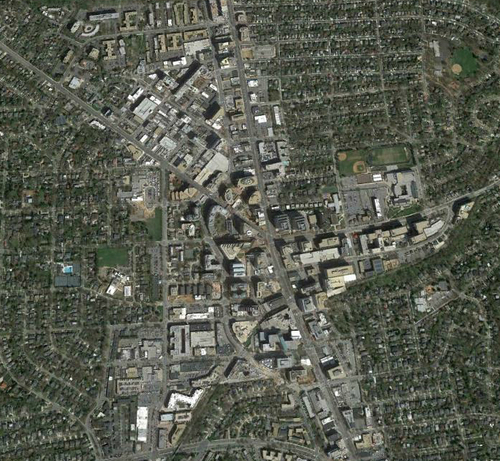There’s a new group opposing a more urban Bethesda
Montgomery County is working on a new master plan for downtown Bethesda that would promote continued development and might allow the population to increase from 7,210 today to over 18,000. But a group of people who oppose urbanization are gearing up to fight it.
In an email to Bethesda civic leaders on Saturday, former Town of Chevy Chase Mayor Pat Burda revealed plans to form the Coalition of Bethesda Area Residents. Organizers say that they are “angry” at plans for increased density, with special ire toward the quantity of new housing.
While CBAR hopes to draw support from single-family neighborhoods on all sides of downtown Bethesda, the initiative comes from the Town of Chevy Chase, a 1,200-home enclave located southeast of the downtown commercial area. (The town is just one of the many neighborhoods that make up what is generally considered Chevy Chase.)
A report submitted to the town council earlier this month presents what CBAR is trying to accomplish. The central premise of the 13-page document, which is framed as a history of downtown Bethesda development, is the primacy of the single-family house and its owner. Apartments, stores, and offices are welcome only to the extent they serve the residents of nearby homes.
The document is clear in its opposition to development, skipping the usual pieties about planning and community participation. Land use decision-making, it explains, is an “inherently political process.” If one county council can upzone, the winners of the next election can equally well downzone.
The document’s author is Scott Fosler, who was among the early architects of the anti-development movement that has flourished in the Chevy Chase area since the 1970s. This movement, acting under a variety of organizational umbrellas, has had a strong influence on land use policy throughout Montgomery County. It was most recently in the news in 2012, when it tangled with county planning director Rollin Stanley after he referred to some of its leaders as “rich white women.”
Fosler himself served two terms on the Montgomery County Council in the 1980s. He earlier chaired the town’s zoning committee and then served on the town council.
While Fosler insists that homeowners have every right to change the zoning of adjoining properties, there is no reciprocity. He would find it unthinkable to rezone the Town of Chevy Chase to better serve the remainder of the county.
Fosler sees Bethesda’s urban center, even when properly subservient, as an alien intrusion that is best kept at a distance. He outlines the strategy by which the Town of Chevy Chase and its allies have obtained the separation they desire. The downtown is encircled with a “comprehensive cordon” of land occupied by parking lots, parks, and house-sized structures. The function of this territory is simply to be as empty and little-used as possible. Property on Elm Street that was made a park would serve the purpose just as well if it were a parking lot.
In the past, the anti-development movement had great influence over land use in Bethesda and Chevy Chase. The 1976 Bethesda master plan imposed a five-fold reduction in the allowable square footage of the downtown. The 1998 plan for Friendship Heights limits buildings on some stretches of Wisconsin Avenue to three stories.
But public opinion is shifting as the demand for urban living grows. Divisions have emerged even within the Town of Chevy Chase. Whether CBAR can achieve the same political power as its predecessors remains to be seen.

